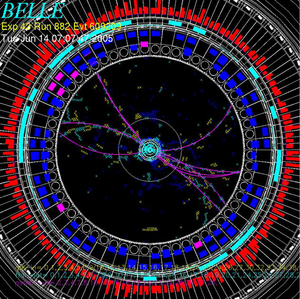Aug. 18, 2006 Research Highlight Physics / Astronomy
High-energy collision highlights quantum quirk
Uneven explosion of quarks spotted in particle accelerator
 Figure 1: This computer-generated image shows the scatter of particles produced in an electron-positron collision.
Figure 1: This computer-generated image shows the scatter of particles produced in an electron-positron collision.
The first experimental confirmation of a subtle effect predicted by quantum theory could lead to a better understanding of how the particles at the heart of every atom acquire properties such as spin, physicists say.
The protons inside each atomic nucleus were once thought to be indivisible, fundamental particles. But in the 1960s, physicists realized that protons were each composed of three particles called quarks, and that these constituents were bound together by a powerful short-range force, dubbed the ‘strong’ force.
Scientists can now generate and study quarks using facilities such as the Belle detector at the KEK-B particle accelerator in Tsukuba. KEK-B accelerates electrons and their antimatter counterparts, positrons, very close to the speed of light, before smashing them together. This creates two new particles—a quark and an antiquark—that fly in opposite directions away from the point of impact.
About 79 million of these collisions were recently analyzed by an international team of researchers led by Ralf Seidl of the RIKEN BNL Research Center, New York, US. The team reports their findings Physical Review Letters 1.
Quantum surprise
The quarks generated in the collisions cannot exist on their own for long. As they hurtle away from each other, each quark uses up some energy to create a partner antiquark. This stabilized quark–antiquark pair usually constitutes a particle known as a pion, whose violent birth jolts it into a different trajectory than its progenitor quark.
One might expect these pions to scatter evenly around the point of collision. But the laws of quantum mechanics had a surprise in store—on average, pions on one side of the collision tend to move along a slightly steeper trajectory.
Adding together the results from all 79 million collisions, it appears that the two sets of pions on either side of the impact point are actually moving asymmetrically, as though there were some intrinsic bias in this subatomic game of billiards (Fig. 1).
This was actually predicted by physicist John Collins in the early 1990s, and Seidl’s team believes their experiment is the first confirmation of the so-called Collins effect. This underpins a key part of quantum chromodynamics (QCD), the theory that describes how quarks stick together. “It is really a very special probe to observe the nature of QCD,” says Seidl.
Confirming this part of the theory, and precisely measuring the effect, could now lead to a deeper understanding of how the properties of protons are determined by their constituent quarks, he says.
References
- 1. Seidl, R., Hasuko, K., Abe, K., Adachi, I., Aihara, H., Anipko, D., Asano, Y., Aushev, T., Bakich, AM., Balagura, V. et al. Measurement of azimuthal asymmetries in inclusive production of hadron pairs in e+e- annihilation at Belle. Physical Review Letters 96, 232002 (2006). doi: 10.1103/PhysRevLett.96.232002
